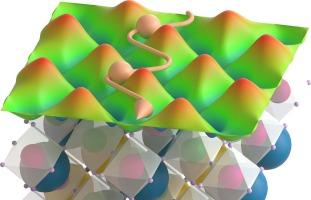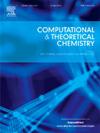Cr adsorption and diffusion on LSCF surface: a first-principles study
IF 3
3区 化学
Q3 CHEMISTRY, PHYSICAL
引用次数: 0
Abstract
To address the Cr poisoning issue in the cathode of Solid Oxide Fuel Cell, it is essential to investigate the adsorption and diffusion of Cr atoms on the surface of lanthanum strontium cobalt ferrite (LSCF) cathodes to uncover the Cr poisoning mechanism. This work systematically calculates the potential energy surface (PES) for the adsorption of Cr atoms on the La(Sr)![]() O-terminated (1 0 0) surface of LSCF. The possible diffusion paths of Cr atoms are derived from the PES, and the diffusion properties are further examined using the CI-NEB method. The results indicate that the lowest adsorption energy of the Cr atom is −6.760 eV at the Hollow sites. Two Cr diffusion paths across the entire surface in the x and y directions are also identified. The charge transfer among different atoms during the diffusion process is analyzed using Bader charge analysis, and the COHP method is employed to further reveal the bonding characteristic of Cr atoms on the surface. During the diffusion process, Cr atoms dynamically form and break bonds with surface oxygen atoms. This study provides theoretical insights to support subsequent experiments aimed at reducing the Cr poisoning effect on the LSCF surface.
O-terminated (1 0 0) surface of LSCF. The possible diffusion paths of Cr atoms are derived from the PES, and the diffusion properties are further examined using the CI-NEB method. The results indicate that the lowest adsorption energy of the Cr atom is −6.760 eV at the Hollow sites. Two Cr diffusion paths across the entire surface in the x and y directions are also identified. The charge transfer among different atoms during the diffusion process is analyzed using Bader charge analysis, and the COHP method is employed to further reveal the bonding characteristic of Cr atoms on the surface. During the diffusion process, Cr atoms dynamically form and break bonds with surface oxygen atoms. This study provides theoretical insights to support subsequent experiments aimed at reducing the Cr poisoning effect on the LSCF surface.

Cr在LSCF表面的吸附和扩散:第一性原理研究
为了解决固体氧化物燃料电池阴极的Cr中毒问题,有必要研究Cr原子在镧锶钴铁氧体(LSCF)阴极表面的吸附和扩散,以揭示Cr中毒机制。本文系统地计算了Cr原子在LSCF的La(Sr) o端(1 0 0)表面吸附的势能面(PES)。通过PES推导出了Cr原子可能的扩散路径,并用CI-NEB方法进一步研究了Cr原子的扩散特性。结果表明,Cr原子在空心位点的最低吸附能为- 6.760 eV。在x和y方向上也确定了穿过整个表面的两条Cr扩散路径。利用Bader电荷分析分析了扩散过程中不同原子间的电荷转移,并利用COHP方法进一步揭示了表面Cr原子的成键特性。在扩散过程中,Cr原子动态地与表面氧原子形成或断开键。该研究为后续旨在减少Cr对LSCF表面影响的实验提供了理论见解。
本文章由计算机程序翻译,如有差异,请以英文原文为准。
求助全文
约1分钟内获得全文
求助全文
来源期刊

Computational and Theoretical Chemistry
CHEMISTRY, PHYSICAL-
CiteScore
4.20
自引率
10.70%
发文量
331
审稿时长
31 days
期刊介绍:
Computational and Theoretical Chemistry publishes high quality, original reports of significance in computational and theoretical chemistry including those that deal with problems of structure, properties, energetics, weak interactions, reaction mechanisms, catalysis, and reaction rates involving atoms, molecules, clusters, surfaces, and bulk matter.
 求助内容:
求助内容: 应助结果提醒方式:
应助结果提醒方式:


